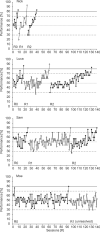Serial visual reversal learning in harbor seals (Phoca vitulina)
- PMID: 35864326
- PMCID: PMC9617845
- DOI: 10.1007/s10071-022-01653-1
Serial visual reversal learning in harbor seals (Phoca vitulina)
Abstract
Progressively improving performance in a serial reversal learning (SRL) test has been associated with higher cognitive abilities and has served as a measure for cognitive/behavioral flexibility. Although the cognitive and sensory abilities of marine mammals have been subject of extensive investigation, and numerous vertebrate and invertebrate species were tested, SRL studies in aquatic mammals are sparse. Particularly in pinnipeds, a high degree of behavioral flexibility seems probable as they face a highly variable environment in air and underwater. Thus, we tested four harbor seals in a visual two-alternative forced-choice discrimination task and its subsequent reversals. We found significant individual differences in performance. One individual was able to solve 37 reversals showing progressive improvement of performance with a minimum of 6 errors in reversal 33. Two seals mastered two reversals, while one animal had difficulties in learning the discrimination task and failed to complete a single reversal. In conclusion, harbor seals can master an SRL experiment; however, the performance is inferior to results obtained in other vertebrates in comparable tasks. Future experiments will need to assess whether factors such as the modality addressed in the experiment have an influence on reversal learning performance or whether indeed, during evolution, behavioral flexibility has not specifically been favored in harbor seals.
Keywords: Behavioral flexibility; Cognition; Pinniped; Progressive improvement; Visual discrimination.
© 2022. The Author(s).
Conflict of interest statement
The authors declare that they do not have a conflict of interest.
Figures






Similar articles
-
Well-developed spatial reversal learning abilities in harbor seals (Phoca vitulina).Anim Cogn. 2022 Oct;25(5):1195-1206. doi: 10.1007/s10071-022-01651-3. Epub 2022 Jul 16. Anim Cogn. 2022. PMID: 35841437 Free PMC article.
-
Does Vibrissal Innervation Patterns and Investment Predict Hydrodynamic Trail Following Behavior of Harbor Seals (Phoca vitulina)?Anat Rec (Hoboken). 2019 Oct;302(10):1837-1845. doi: 10.1002/ar.24134. Epub 2019 May 3. Anat Rec (Hoboken). 2019. PMID: 30980470
-
Underwater sound localization of pure tones in the median plane by harbor seals (Phoca vitulina).J Acoust Soc Am. 2016 Dec;140(6):4490. doi: 10.1121/1.4972531. J Acoust Soc Am. 2016. PMID: 28040008
-
Aerial single target acuity of harbor seals (Phoca vitulina) for stationary and moving targets of varying contrast.Vision Res. 2024 May;218:108389. doi: 10.1016/j.visres.2024.108389. Epub 2024 Mar 25. Vision Res. 2024. PMID: 38531191
-
Space use of Pacific harbor seals (Phoca vitulina richardii) from two haulout locations along the Oregon coast.PLoS One. 2019 Jul 31;14(7):e0219484. doi: 10.1371/journal.pone.0219484. eCollection 2019. PLoS One. 2019. PMID: 31365532 Free PMC article.
Cited by
-
Well-developed spatial reversal learning abilities in harbor seals (Phoca vitulina).Anim Cogn. 2022 Oct;25(5):1195-1206. doi: 10.1007/s10071-022-01651-3. Epub 2022 Jul 16. Anim Cogn. 2022. PMID: 35841437 Free PMC article.
-
Going back to "basics": Harlow's learning set task with wolves and dogs.Learn Behav. 2024 Dec;52(4):315-329. doi: 10.3758/s13420-024-00631-6. Epub 2024 May 23. Learn Behav. 2024. PMID: 38780876 Free PMC article.
-
PyGellermann: a Python tool to generate pseudorandom series for human and non-human animal behavioural experiments.BMC Res Notes. 2023 Jul 5;16(1):135. doi: 10.1186/s13104-023-06396-x. BMC Res Notes. 2023. PMID: 37403146 Free PMC article.
-
Serial visual reversal learning in captive black-handed spider monkeys, Ateles geoffroyi.Anim Cogn. 2024 Aug 13;27(1):56. doi: 10.1007/s10071-024-01897-z. Anim Cogn. 2024. PMID: 39136822 Free PMC article.
References
-
- Beach FA, III, Pepper RL, Simmons JV, Nachtigall PE, Siri PA. Spatial habit reversal in two species of marine mammals. Psychol Rec. 1974;24:385–391. doi: 10.1007/BF03394257. - DOI
-
- Bebus SE, Small TW, Jones BC, Elderbrock EK, Schoech SJ. Associative learning is inversely related to reversal learning and varies with nestling corticosterone exposure. Anim Behav. 2016;111:251–260. doi: 10.1016/j.anbehav.2015.10.027. - DOI
MeSH terms
LinkOut - more resources
Full Text Sources
Miscellaneous

